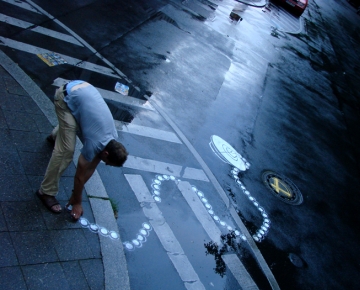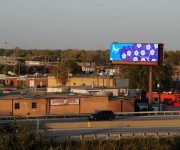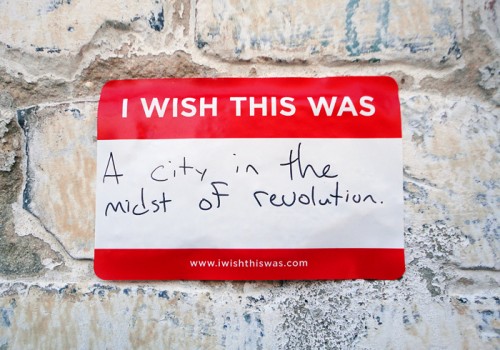“Window,” a photograph by L.A. artist Susanna Battin, appeared on a San Bernardino County billboard in December.Photo: Susanna BattinIf you drove down I-15 in San Bernardino County, Calif., outside of Corona, last Friday, you may have noticed a giant, digital billboard exclaiming, “WE BUY USED GUNS.” But if you’d looked at the same sign from the opposite direction, rather than being socked in the mouth with a solicitation to sell your sidearm, you’d have seen a crystal clear window — a view right through the sign of the undulating ridge of the Santa Ana Mountain Range beyond.
The image was the handiwork of 25-year-old Los Angeles-based artist Susanna Battin. She spent weeks getting the image just right, befriending the assistant manager of a nearby hotel, who let her up on the roof to take pictures of the mountains, then using Google Street View to make sure she had the perspective perfect to create the illusion for motorists. The image, displayed digitally, was set to slowly fade, as though a clear day was gradually turning smoggy.
“Oftentimes our interactions with the natural world are mediated by our lives as consumers,” Battin said of the piece. “It’s not about going out into the environment, it’s about purchases — what you’re wearing or how you look. Maybe you don’t even leave your house. You watch a documentary. You see the world through someone else’s window. This is my window.”
Battin’s work was a part of the Billboard Art Project, a nationwide effort hatched by Richmond, Va., artist David Morrison. Since its start a few years ago, the project has displayed the work of hundreds of artists on digital billboards around the country, turning a landscape of corporate advertising into supersized, outdoor art galleries.
Intrigued, I threw a few questions at Morrison via e-mail, and he was gracious enough to respond.
Q. How is it that you came to be the mastermind of this thing?
A. The impetus for the Billboard Art Project came probably a little over five years ago when I worked a short stint as a car salesman. I was stuck in some slow-moving traffic on the way to work when a digital billboard was being installed. They were running test images from a Windows operating system — the stock wallpaper photos of a field of flowers, the Golden Gate Bridge, a desert landscape — and it was striking to see these images … in a space dedicated to corporate hawkings. I wanted to replicate that experience for drivers and pedestrians on some level by putting up some images of my own.
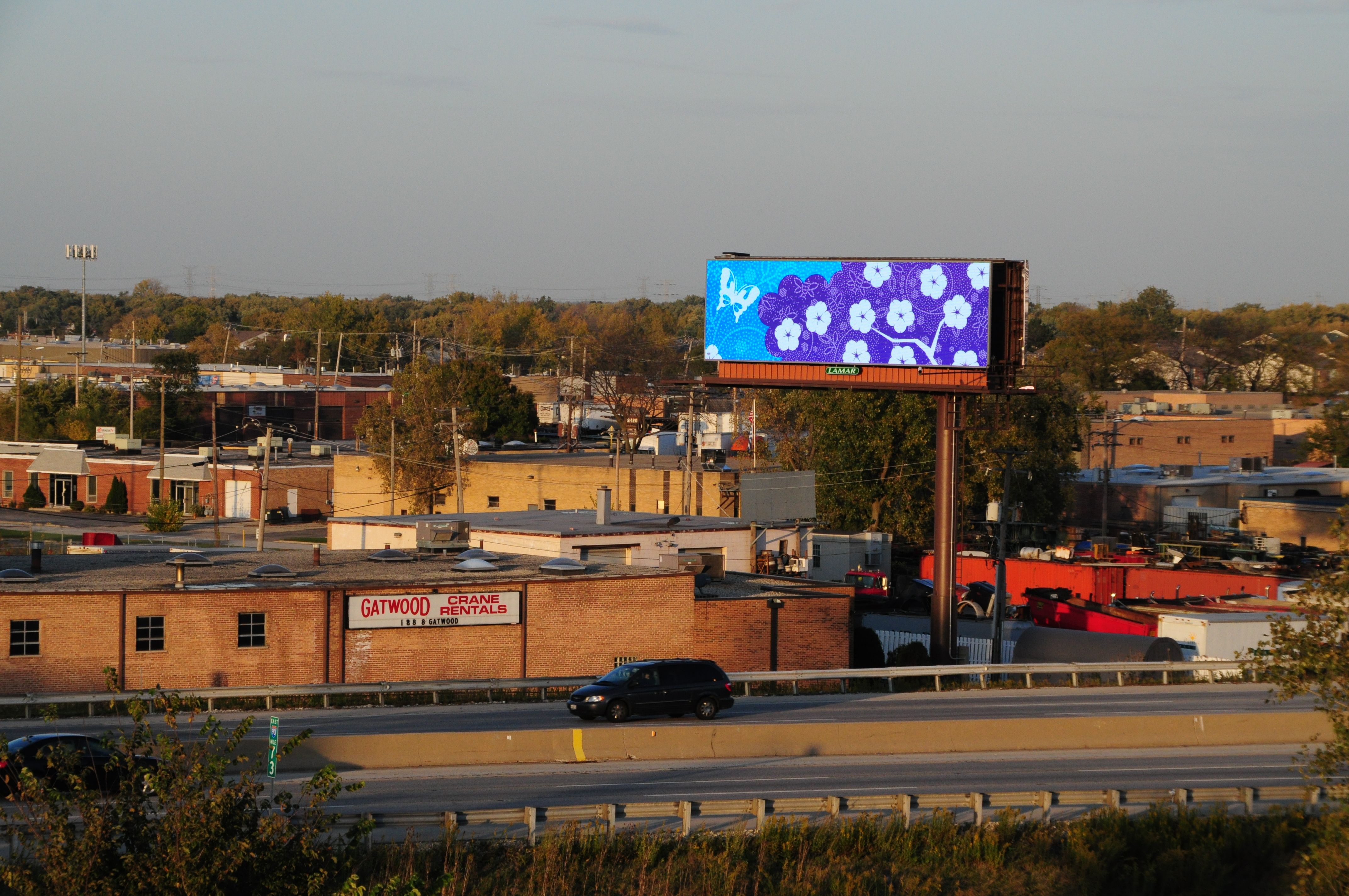 Billboard in Chicago. Image by Lisa Graham.Photo: The Billboard Art ProjectYears later, I approached a Lamar Advertising representative about renting a billboard for 24 hours. Once I got a contract, I started discussing the opportunity with friends and they wanted to join in. Opening up the venue to other artists seemed like a natural extension of the original idea of humanizing this corporate space, so word got around and we ended up having artists join in from all over the United States and a few from other parts of the world. The first show consisted of 36 different artists and over 3,000 images … Lots of people came out and it was such an experience that there was sort of this nagging [feeling] that we had to do it again. And again and again.
Billboard in Chicago. Image by Lisa Graham.Photo: The Billboard Art ProjectYears later, I approached a Lamar Advertising representative about renting a billboard for 24 hours. Once I got a contract, I started discussing the opportunity with friends and they wanted to join in. Opening up the venue to other artists seemed like a natural extension of the original idea of humanizing this corporate space, so word got around and we ended up having artists join in from all over the United States and a few from other parts of the world. The first show consisted of 36 different artists and over 3,000 images … Lots of people came out and it was such an experience that there was sort of this nagging [feeling] that we had to do it again. And again and again.
Q. How is the Billboard Art Project funded? Do you have to pay for the “advertising” time on the billboards, or does the company donate it?
A. Up until recently, I’ve footed the bill for the entire project. We’ve been working to get 501(c)3 exemption status … since July and it is taking longer than we expected. We pay full price for the billboards. Some advertising companies are inclined to donate time on their vinyl billboards, but not the digitals.
Q. Does the owner of the billboards see this as devious or subversive? It’s something of an anti-advertising message, no?
A. To date, we’ve been working with Lamar Advertising exclusively, not really by choice so much as out of the convenience of not having to forge new relationships with companies that are not used to providing the type of service we need. You see, CBS, Clear Channel, Lamar, Adams, Next Media — they sell advertising space, simple contracts that consist of a few images that get displayed for months on end. We come along and want to rent a board for a day and put thousands of different images on the display, interrupting a native schedule and creating more work in the sense that they have to go through all those images for the sake of public decency. We are essentially asking someone who makes cars to make airplanes instead.
 Billboard in Baton Rouge, La. Image by Marcellous Lovelace.Photo: The Billboard Art ProjectI’ve never spoken to the owner of Lamar about their opinion of what we do, but in general, I think the company and the local markets just look at the project as sort of an oddity and a paycheck … Clear Channel in San Antonio [recently] did something similar to what we are doing when they showcased art from 40 different local artists on 19 different billboards all over town. I believe the art was interspersed with advertising, but their effort to reach out to the community with this new medium makes sense on so many different levels. It is a good thing for the artists to have that exposure, it’s a good thing for the advertising companies because people might actually pay attention, and Clear Channel demonstrates a social conscience through its participation with the community. Everybody wins.
Billboard in Baton Rouge, La. Image by Marcellous Lovelace.Photo: The Billboard Art ProjectI’ve never spoken to the owner of Lamar about their opinion of what we do, but in general, I think the company and the local markets just look at the project as sort of an oddity and a paycheck … Clear Channel in San Antonio [recently] did something similar to what we are doing when they showcased art from 40 different local artists on 19 different billboards all over town. I believe the art was interspersed with advertising, but their effort to reach out to the community with this new medium makes sense on so many different levels. It is a good thing for the artists to have that exposure, it’s a good thing for the advertising companies because people might actually pay attention, and Clear Channel demonstrates a social conscience through its participation with the community. Everybody wins.
To your query about it being devious or subversive or something of an anti-advertising piece, it really isn’t. The Billboard Art Project is about so many different things. We’re challenging people’s normal, everyday expectations by giving them something they are not expecting in a place they’d never think to look. We’re giving artists an opportunity to develop sight-specific work for a new form of digital media that seems to be getting more and more pervasive. We’re democratizing art on some levels by accepting artwork from everyone and just putting it out there for everyone to enjoy.
There’s nothing intrinsically evil about advertising. People and businesses need to get a message across to other people about what they do so they can keep doing it. Sometimes you may not like what they do or what they are selling, but that is something totally different. And maybe you don’t want to be treated like a consumer 24/7, but that is what people do. We just want them to consume something a little bit more benign and maybe infuse their day with a little beauty and thoughtfulness.
Q. Can you give me a sense of the range of different pieces that you’ve run?
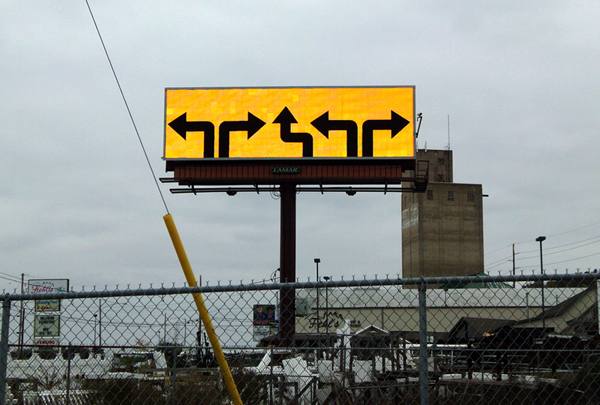 Billboard in Reading, Penn. Image by Michele Guieu.Photo: The Billboard Art ProjectA. I can only touch on some of the things people have done. Some artists put up previous work and adapt it to the billboard. Some people develop things specifically for the format, like Susanna [Battin]. There are a lot of sequential submissions that work as a unit as well as individual images. Some artists play with the fact that it is a sign and create pieces around that. Visit our website and follow the links to Flickr and YouTube. There’s some exciting stuff.
Billboard in Reading, Penn. Image by Michele Guieu.Photo: The Billboard Art ProjectA. I can only touch on some of the things people have done. Some artists put up previous work and adapt it to the billboard. Some people develop things specifically for the format, like Susanna [Battin]. There are a lot of sequential submissions that work as a unit as well as individual images. Some artists play with the fact that it is a sign and create pieces around that. Visit our website and follow the links to Flickr and YouTube. There’s some exciting stuff.
Q. What next?
A. Plenty more to come. We want this to happen on a massive scale. On a national level, we are hoping to incorporate the works of local students — K-12 and from colleges and universities — as well as artists from all over the world. We are also looking to make much longer buys in each market we visit to gain higher visibility and give more people who might not experience art the chance to discover something very wonderful.
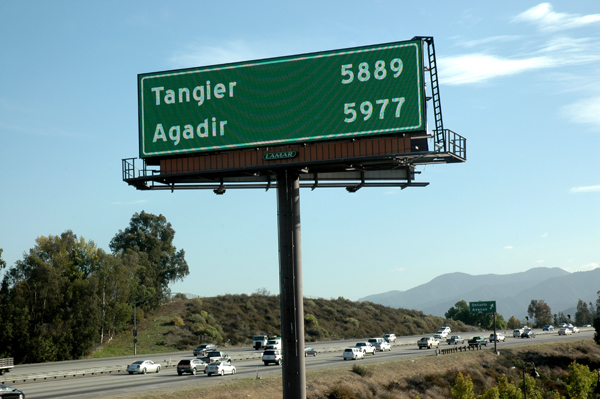 Billboard in Corona, Calif. Image by Michele Guieu.Photo: The Billboard Art ProjectOnce we get that 501(c)3 tax status, the sky is the limit (pun intended). It’s … not [going to happen] without the help of sponsors and donors.
Billboard in Corona, Calif. Image by Michele Guieu.Photo: The Billboard Art ProjectOnce we get that 501(c)3 tax status, the sky is the limit (pun intended). It’s … not [going to happen] without the help of sponsors and donors.
This is not my project; it’s an idea that I happened to discover and execute. Anyone could have done this and probably would have if I had not. But look at the Billboard Art Project as an opportunity for everyone interested to change their public landscape, to humanize it in a small way and make it fresh and new and exciting. When people get charged and excited about something positive like this the way they do, it can’t help but spread.
